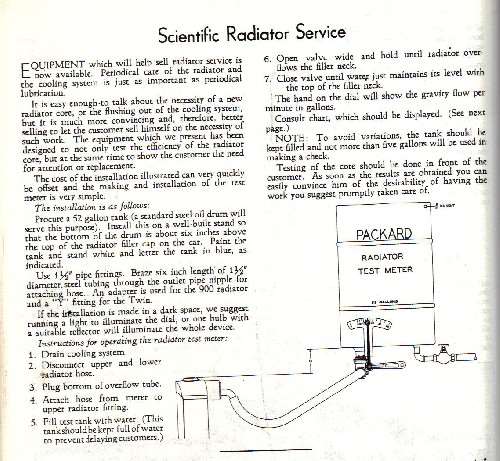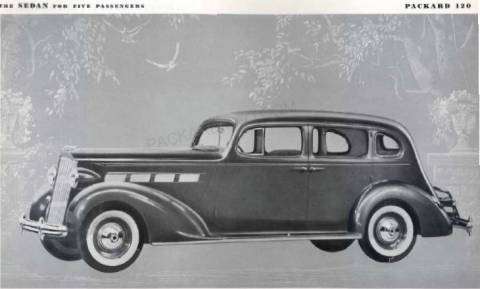|
Re: Anyone develop a radiator flow test without removing it?
|
||||
|---|---|---|---|---|
|
Forum Ambassador

|
Maybe I'm missing something here - no need to remove thre radiator from the car that I'm aware of; I've done but a few gravity flow rate tests on radiators and have done them with the radiator mounted in the car.
Hoist a 50 gallon steel drum such that the base is a foot or less above the upper radiator tank and fix the outlet of the drum with a valve and hose going into the top radiator tank. The valve should be a large bore (1-1/2" or so) and as large a hose as will fit into the radiator gooseneck. Remove the lower radiator hose. Put 36 gallons of water into the tank (or half as much if you want to time it for 30 seconds which would allow you to use a smaller drum), start your clock and open the valve. You may have to modulate the valve if the overhead tank delivers faster than the radiator can pass the water; just adjust the valve constantly so as to loose as little water as possible at the filler, yet not allowing the top radiator tank to go dry - that's the key to getting a valid test, along with having a tank valve and hose that can deliver (with the valve fully open) water faster than the radiator can pass it. You don't want to seal the joint between the tank and radiator gooseneck as the test is for "gravity" flow rate and trying to seal the connection at the radiator fill point would add a pressure from the head of the water in the tank. There is a decent illustration of this in one of the Packard service documents, if I run across it today I'll add it here. PS - here's the method shown in the Service Letters. As you can see the radiator has not been removed from the car. The difference with this method is that the valve has a scale which gives the flow rate; without that little device you will have to time how long it takes to pass the specified number of gallons. Note that they use a flange mounted to the shutter thermostat opening rather than filling thru the radiator cap opening - making that little flange would make doing the test much simplier and neater for you - just modulate the valve to keep the top tank filled. Hope this helps - it's a messy little job but is the best way to evaluate the cooling capacity of a radiator core.
Posted on: 2014/11/6 10:22
|
|||
|
||||
|
Re: Anyone develop a radiator flow test without removing it?
|
||||
|---|---|---|---|---|
|
Home away from home
|
Many thanks for the prompt reply!
Very interesting that Packard had issued that solution! When was that published? Guess I will have to fabricate a tub to catch all that water so it doesn't make a mess in the shop.
Posted on: 2014/11/6 22:18
|
|||
|
||||
|
Re: Anyone develop a radiator flow test without removing it?
|
||||
|---|---|---|---|---|
|
Forum Ambassador

|
When was that published?
Service Letters, 1931 or 1932 as I recall.
Posted on: 2014/11/6 23:52
|
|||
|
||||
|
Re: Anyone develop a radiator flow test without removing it?
|
||||
|---|---|---|---|---|
|
Home away from home

|
Why not just a 5 gallon bucket full of water and time it for 10 seconds.???? Repeat it 2 or 3 times if necessary. Would'nt that be easier or at least close enuf for rock'n roll???
Posted on: 2014/11/7 15:29
|
|||
|
VAPOR LOCK demystified: See paragraph SEVEN of PMCC documentaion as listed in post #11 of the following thread:f
packardinfo.com/xoops/html/modules/newbb/viewtopic.php?topic_id=7245 |
||||
|
||||
|
Re: Anyone develop a radiator flow test without removing it?
|
||||
|---|---|---|---|---|
|
Home away from home

|
Bujack. Are u having somekind of cooling system problems???
Posted on: 2014/11/7 15:33
|
|||
|
VAPOR LOCK demystified: See paragraph SEVEN of PMCC documentaion as listed in post #11 of the following thread:f
packardinfo.com/xoops/html/modules/newbb/viewtopic.php?topic_id=7245 |
||||
|
||||
|
Re: Anyone develop a radiator flow test without removing it?
|
||||
|---|---|---|---|---|
|
Home away from home

|
wait a minute. I went back and read the rad flow document in post #2 above. Look CLOSE at the right hand side of the instructions begining with "NOTE".
So one only really needs a 5 gallon test. Not a 30 gallon test.
Posted on: 2014/11/7 15:55
|
|||
|
VAPOR LOCK demystified: See paragraph SEVEN of PMCC documentaion as listed in post #11 of the following thread:f
packardinfo.com/xoops/html/modules/newbb/viewtopic.php?topic_id=7245 |
||||
|
||||
|
Re: Anyone develop a radiator flow test without removing it?
|
||||
|---|---|---|---|---|
|
Forum Ambassador

|
So one only really needs a 5 gallon test
Not entirely true if you want an accurate measurement. They only needed 5 gallons or so because they had a discharge valve calibrated in gallons per minute of flow rate.
Posted on: 2014/11/7 16:03
|
|||
|
||||
|
Re: Anyone develop a radiator flow test without removing it?
|
||||
|---|---|---|---|---|
|
Home away from home

|
I noticed the flow meter in the picture. However note that instruction for building the tank and stand and fittings etc there is no mention of a flow meter. Minor critical detail on my part i suppose.
After reading the procedure instructions closer: Then one mite simply fill the radiator. Then release the water in the filled radiator (start the stop watch) while pouring in a 5 gal bucket of water thru the filler neck of rad. When it all runs out stop the stop watch,add rad capaacity to the 5 gallons and then do the math. That should simulate precisely what the large equipment would do falling slightly short of the added force from the Packards test tank height (which can also be compensated for but probably negligable).
Posted on: 2014/11/7 16:25
|
|||
|
VAPOR LOCK demystified: See paragraph SEVEN of PMCC documentaion as listed in post #11 of the following thread:f
packardinfo.com/xoops/html/modules/newbb/viewtopic.php?topic_id=7245 |
||||
|
||||
|
Re: Anyone develop a radiator flow test without removing it?
|
||||
|---|---|---|---|---|
|
Home away from home

|
Let me put it another way:
The 5 gallon bucket can be handled by hand. Alot easier and safer than trying to dangle 200 pounds of water and drum some 5 or 6 feet in the air and buying flow meters.
Posted on: 2014/11/7 16:30
|
|||
|
VAPOR LOCK demystified: See paragraph SEVEN of PMCC documentaion as listed in post #11 of the following thread:f
packardinfo.com/xoops/html/modules/newbb/viewtopic.php?topic_id=7245 |
||||
|
||||

 (211.30 KB)
(211.30 KB)







